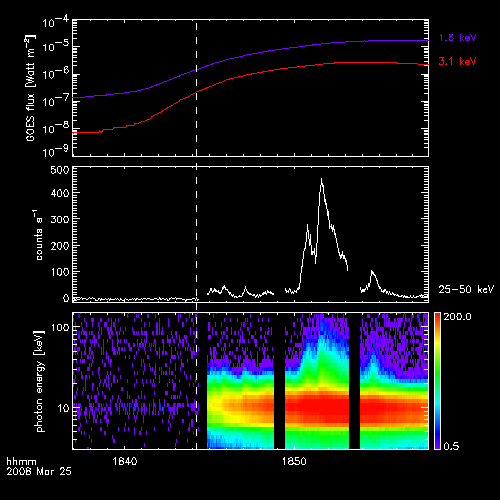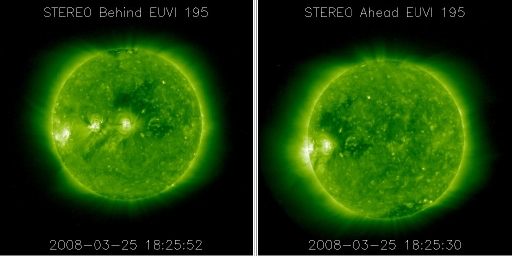A STEREO/RHESSI Flare at Solar Minimum
| Nugget | |
|---|---|
| Number: | 73 |
| 1st Author: | Hugh Hudson |
| 2nd Author: | Säm Krucker |
| Published: | 1 January 2008 |
| Next Nugget: | Anisotropy of RHESSI hard X-ray emission |
| Previous Nugget: | Saturation of Nonthermal Hard X-ray Emission in Solar Flares |
Introduction
It seems that a solar cycle often ends with a bang, rather than a whimper. We saw this in the "last best flare" of sunspot cycle 22, the previous one when the remarkable flare seismic waves were originally discovered by Kosovichev and Zharkova (Ref. [1]). Lo and behold! Cycle 23 has done something similar with a flare on March 25, 2008. One might say it is overdue, since that time interval (11.75 years) is longer than the average solar cycle, at least lately. This flare many not have been really unusual (but see below), however its impact will be great because it is the first major CME/dimming event well-observed in full perspective by the STEREO spacecraft.
RHESSI observations
We first take a quick look at RHESSI time variations (Figure 1 below) and find a little surprise. The Neupert effect usually describes the relationship between hard and soft X-ray time variations in a flare. It results from the accumulation of hot plasma (the source of soft X-rays) in the lower corona as the flare develops (marked by the hard X-rays). This flare does not show the Neupert effect very well, and is immediately interesting because of this.


What to do?
The Sun has served up an interesting flare at a normally boring time, solar minimum. Its time variations are strange but its RHESSI images look normal. Analysis is just beginning on this event, but it is clear that somebody should do a detailed analysis. Fortunately, because of the unprecedented data that are available, somebody will soon do so and we will faithfully report it in a future Nugget. Whoever does this will certainly want to make use of the STEREO observations, which the movie linked to Figure 3 sketches out.

A keen eye, looking at this movie, can see a coronal dimming in the images from the Behind spacecraft, and note that it is not visible in the Ahead images. The two STEREO spacraft are now separated by tens of degrees - check out the STEREO orbit tool to learn more. Unfortunately the stereoscopy may be a little bit more informative for the CME, high in the corona, than for the flare, which was occulted at Ahead. But still we have the stereo pair of SOHO (or TRACE) and Ahead.
Biographical Note
Hugh Hudson (text/figures) and Säm Krucker (figures/text) are senior RHESSI researchers at the University of California, Berkeley.